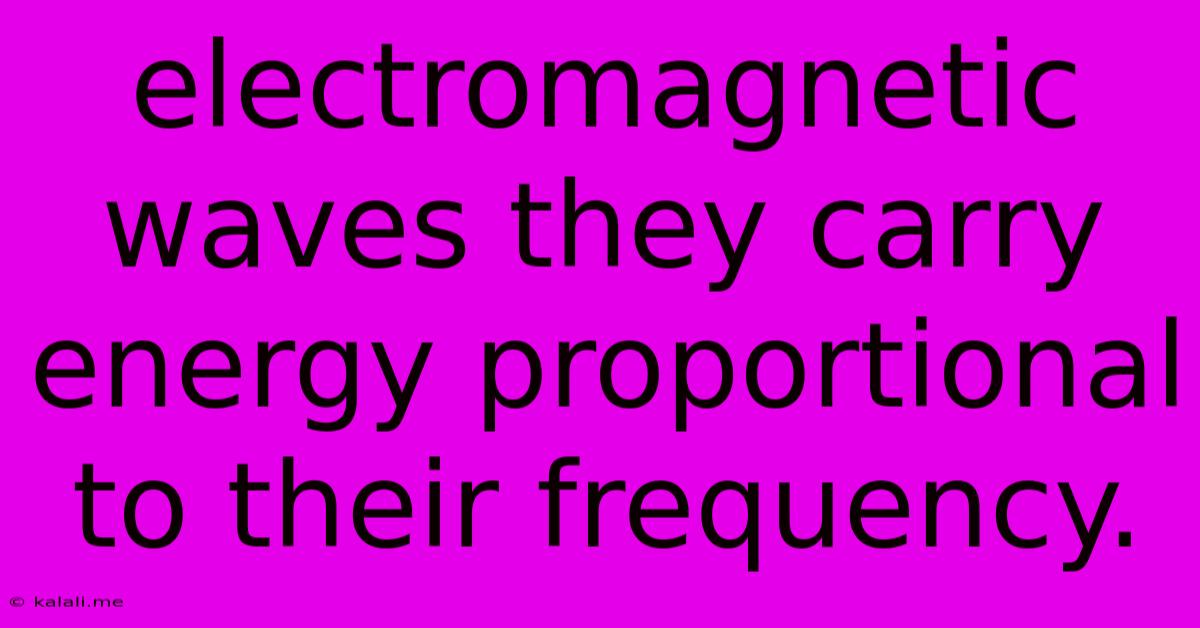Electromagnetic Waves They Carry Energy Proportional To Their Frequency.
Kalali
Jun 01, 2025 · 3 min read

Table of Contents
Electromagnetic Waves: Energy Proportional to Frequency
Electromagnetic (EM) waves are a fundamental aspect of physics, impacting everything from the light we see to the radio waves that power our communication systems. A crucial property of these waves is their energy, which is directly proportional to their frequency. This relationship, a cornerstone of quantum mechanics, explains a wide range of phenomena and has profound implications for various technologies. This article delves into the connection between the energy of electromagnetic waves and their frequency, exploring the underlying physics and real-world applications.
Understanding Electromagnetic Waves
EM waves are disturbances that propagate through space by the interplay of oscillating electric and magnetic fields. These fields are perpendicular to each other and to the direction of wave propagation, creating a transverse wave. They don't require a medium to travel, unlike sound waves, allowing them to move through the vacuum of space at the speed of light (approximately 3 x 10<sup>8</sup> m/s). The electromagnetic spectrum encompasses a broad range of frequencies, including radio waves, microwaves, infrared radiation, visible light, ultraviolet radiation, X-rays, and gamma rays.
The Energy-Frequency Relationship: Planck's Constant
The energy (E) of an electromagnetic wave is directly proportional to its frequency (ν), a relationship elegantly described by Planck's equation:
E = hν
where 'h' is Planck's constant, approximately 6.626 x 10<sup>-34</sup> Js. This equation reveals a fundamental quantum nature of light and EM radiation: energy is quantized, meaning it exists in discrete packets called photons. Each photon's energy is directly proportional to the wave's frequency; higher frequency waves have higher energy photons.
Implications of the Energy-Frequency Relationship
This seemingly simple equation has far-reaching consequences:
-
Visible Light and Color: Different colors of visible light correspond to different frequencies. Violet light, having the highest frequency within the visible spectrum, carries more energy per photon than red light, which has the lowest frequency. This explains why ultraviolet light, with even higher frequencies than violet, can cause sunburns – its higher energy photons are more likely to damage skin cells.
-
Medical Imaging: X-rays and gamma rays, possessing extremely high frequencies and thus high energy photons, are used in medical imaging due to their ability to penetrate tissues. The high energy allows them to pass through soft tissue but be absorbed by denser materials like bones, creating contrasting images.
-
Communication Technologies: Radio waves and microwaves, with lower frequencies and lower energy photons, are used in communication technologies because they can travel long distances with less energy loss compared to higher frequency waves. However, their lower energy limits their penetration capabilities.
-
Solar Energy: The sun emits a wide range of electromagnetic radiation. The visible and ultraviolet portions of sunlight carry significant energy, and this energy is harnessed using solar panels to generate electricity. The efficiency of solar panels is related to their ability to absorb photons of various frequencies and convert that energy into electricity.
-
Photoelectric Effect: This effect demonstrates the quantization of light. When light shines on a metal surface, electrons are emitted only if the light's frequency exceeds a certain threshold, regardless of intensity. This can only be explained by the particle-like nature of light and the energy-frequency relationship.
Conclusion:
The direct proportionality between the energy of an electromagnetic wave and its frequency is a foundational concept in physics with profound implications across various fields. Understanding this relationship is crucial to comprehending how we interact with the electromagnetic spectrum and how we utilize it for numerous applications in medicine, communication, energy generation, and countless other areas. From the warmth of infrared radiation to the power of X-rays, the energy carried by these waves, dictated by their frequency, continues to shape our understanding of the universe and drive technological advancements.
Latest Posts
Latest Posts
-
Wiring Diagram For Single Light Switch
Jun 03, 2025
-
In The List Or On The List
Jun 03, 2025
-
Is Bloodborne A Dark Souls Game
Jun 03, 2025
-
Export As 44 Vs 48 Sounds Different
Jun 03, 2025
-
Giving My 120 Percent Not Answerable To Anyone
Jun 03, 2025
Related Post
Thank you for visiting our website which covers about Electromagnetic Waves They Carry Energy Proportional To Their Frequency. . We hope the information provided has been useful to you. Feel free to contact us if you have any questions or need further assistance. See you next time and don't miss to bookmark.